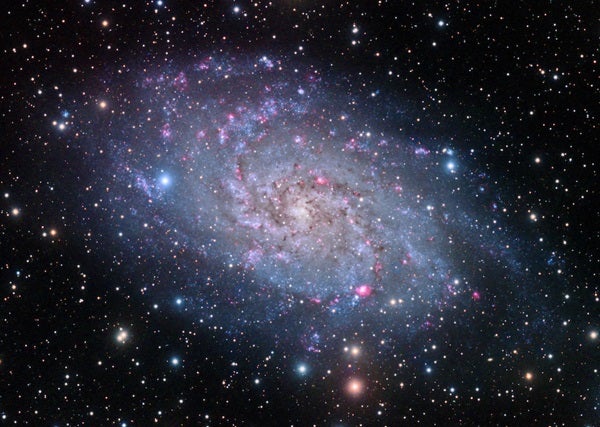Named for the constellation in which it appears, the Triangulum Galaxy (M33) is the third largest member of the Milky Way’s Local Group of galaxies. Only the Andromeda Galaxy and the Milky Way are bigger.
M33 lies about 2.7 million light-years away. And like its hefty galactic neighbors, it is a spiral galaxy. However, unlike Andromeda and the Milky Way, both of which are classified as barred spirals, the Triangulum Galaxy does not exhibit a central bar-shaped structure. Its spiral arms instead extend directly from its core. The arms of Triangulum are also less tightly wound than those of Andromeda and the Milky Way, stretching out across some 50,000 light-years, or about half the diameter of our own galaxy. M33 holds roughly half as many stars as the Milky Way.
Unlike Andromeda, which we see nearly edge-on, Triangulum presents itself almost face-on. This affords astronomers a great opportunity to study a nearby spiral’s structure.
Many ionized HII regions are scattered across Triangulum’s disk. These pockets of glowing hydrogen gas come to life in photos taken through large ground-based telescopes and the Hubble Space Telescope. The largest HII region in M33 is separately cataloged as NGC 604. Astronomers estimate this massive star-forming borough stretches across more than 1,500 light-years, making it at least some 40 times larger than our own Orion Nebula.
While observers have closely scrutinized the Triangulum Galaxy since its discovery, it’s ironic that it often eludes amateurs trying to spot it for the first time. Even though it is rated at 6th magnitude, M33 has a very low surface brightness due to its large apparent diameter in our sky. That causes it to blend seamlessly into the background. Many searching for M33 pass right over it without even noticing.
It’s easier to spot the galaxy’s glow through the wider fields of binoculars and finder scopes. If you are targeting it through a telescope, however, use averted vision and your lowest-power eyepiece for the best view. Then, once you find the galaxy, try tracking down NGC 604. It will look like a small glowing patch just northeast of M33’s core.
Make sure to explore Astronomy’s full list of 101 cosmic objects you must see. New entries will be added each week throughout 2022.
To get the latest astronomical news and observing content delivered directly to your door, subscribe to Astronomy magazine today!










